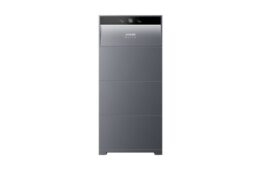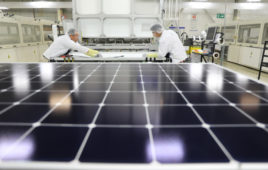What if you could install traditional solar panels on a sloped roof with no penetrations? Not low-watt, adhesive modules; not flexible thin-film; but rigid, glassed, crystalline solar panels on rails.
Impossible, right?
According to not one but two solar mounting companies, it’s possible, and multiple successful installations prove it. In a highly saturated market, mounting manufacturers have continuously innovated to get ahead (rail-less systems were recently considered revolutionary), and the competition is getting even more creative.
Minnesota solar installer Mouli Engineering has UL certification for its SolarPod Crown non-penetrating system, and installers and homeowners alike are asking for the pioneering product. S:FLEX has already installed 3 MW of its Flat Direct non-penetrating solution in Europe, and the company is ready to bring the aerodynamic marvel state-side.
We spoke with both companies to find out how it’s possible to install railed panels without creating any holes in the roof.
SolarPod Crown

SolarPod Crown
The idea for the non-penetrating sloped roof mounting system came from the direct installation experience of Mouli Engineering and its CEO Mouli Vaidyanathan.
“We started as an installer nine years ago, installing conventional legacy systems, drilling holes into the roof,” Vaidyanathan said. “The holes were taking way too much time. You had to find the rafters and then you had to drill the pilot holes and then you had to put on the standoff, then the rails. I didn’t like the entire process. I felt it was too cumbersome and labor intensive.”
Thus the idea for a simplified system that could be installed quickly and with no holes in the roof started to take root. Vaidyanathan designed an entire line of SolarPod plug-and-play systems for easier installation for many applications, but SolarPod Crown is the only one for sloped roofs. The system uses standardized rails bracketed together and “draped” over the peak of the roof. By distributing the panel load, the system manipulates the wind to keep the panels on the roof.
“We have a special bracket that straddles both sides of the ridge,” Vaidyanathan said. “When one side tries to lift, the other side goes downward. It’s like a see-saw upward force being transferred.”
Vaidyanathan said the Crown product works with strain-based loading—if the north side moves, the south side will prevent it from moving further.

SolarPod Crown shown on a church in California
“There is absolutely no point load. It is completely distributed, and not just on one side,” he said. “In a conventional system, on one side you will see the load of the entire roof taken by those rafters. In our system, it is taken by both the north and south side equally because of the weight distribution.”
Along with the full system, Vaidyanathan’s company provides customers with engineering and design plans to ensure a perfect install. Many DIYers come across the SolarPod Crown product, but even contractors are taking notice. A church in California wanted to go solar last year, but its decades-old cement tile roof was a challenge. The church said the roof had lasted many years just fine, so no tiles should be removed or holes made to compromise it. Local installer Electricraft sought out SolarPod Crown and was able to install a 40-kW system on top of the roof’s gable.
Solar panels can “hang” on both sides of the roof or just one. Vaidyanathan said the steeper the roof, the better. As steepness increases, the load transfer becomes more even.
“With conventional systems, you have to put more penetrations on a steep roof. In ours, you don’t have to do any penetrations at all,” he said.
SolarPod Crown is Class A fire rated and has been through wind tunnel and mechanical load testing, in addition to being UL 2703 certified. The system is designed to be non-penetrating, but in especially windy areas, one or two penetrations may be needed. But, as Vaidyanathan pointed out, one or two penetrations is still considerably fewer than a traditional system.
The unique product has been installed on shingle, wood shake, metal, tile and corrugated metal roofs already, and Vaidyanathan has confidence it can work in nearly any situation.
S:FLEX Flat Direct
Germany is often seen as one of the most pro-solar countries in the world. Most roofs that can support solar have it. To continue installing solar, even on roofs where structural issues prevent it, S:FLEX introduced its low-ballasted, non-penetrating racking solution Flat Direct.

S:FLEX Flat Direct, shown with ballast
S:FLEX has been manufacturing a full range of mounting systems since 2009, but its new system opens up the market to previously overlooked applications.
The lightweight Flat Direct system uses the wind to stay on the roof with minimal ballast and no penetrations. Pre-glued foam rubber pads under the base rail provide friction to also help keep the system stable. Flat Direct can be installed double-sided (panels on both sides of the roof) over the ridge, single-sided with a counterweight or single-sided with a ridge connection. The best installation method is dependent on the wind-load and roof-load capacity, said Nils Wollenberg, managing director of the U.S. branch of the German company.
“If you would put an array on top of a roof [with] one module after another and no spacing in between, then usually the wind tries to suck the array upward,” he said. “We designed [Flat Direct] with certain air gaps calculated specifically with our wind tunnel testing that allows the wind to escape. The higher the winds, the more it presses toward the roof. This effect of utilizing the wind and how it flows throughout the array, in addition to the ballast and the distribution of the weight, is the concept of holding it on to the rooftop.”
S:FLEX designed Flat Direct to work with ballast made of standard pavers found at nearly any home improvement store. Spacers delivered with the system hold the pavers in place.
“The ballast is distributed in a way where its only on those load-bearing walls,” Wollenberg said. “When a rooftop has a very low ballast capacity, we usually distribute those loads to where the walls are.”
In some extreme cases, a few attachments are needed with the Flat Direct system where ballast requirements exceed the load capacity of the roof. Normally, a traditional penetrating system with 18 panels—two rows of nine—would need 40 attachments to hold in place, Wollenberg said. S:FLEX’s system would only need four.

S:FLEX Flat Direct can be used on unique rooftops, like this barreled roof
“You can reduce the attachment points to a tenth of conventional or rail-less systems,” Wollenberg said. “Labor is much less because you don’t have to penetrate [as much].”
Although 3 MW of the Flat Direct solution have been installed throughout Europe on TPO, EPDM, rolled asphalt and insulated metal panel rooftops, S:FLEX is still awaiting certification in the United States. Wollenberg said the system should be approved by the end of Q1 this year, and the company has already seen a lot of U.S. interest, especially after showcasing at Solar Power International 2016.
Wollenberg said one of the largest advantages of the Flat Direct system is when re-roofing needs arise. It’s much easier to shift a non-penetrating system and repair a roof underneath than to detach multiple anchors and disassemble an array. Flat Direct also works well on uniquely shaped roofs—like barrel rooftops. An S:FLEX-designed installation plan can ensure Flat Direct sits snugly against the rounded-roof, with limited penetrations.
2020 update: SolarPod Crown is now known as Z Rack.




This is wonderful innovation; thanks for the article. We recently installed a very large (and expensive) solar PV system on our vacation home in Hawaii, and we didn’t even know that there was a possibility of installing without drilling. Had we known, we would would have sought companies out to quote for this.
Hello!
Are these still manufactured? I searched for the link but it is no longer active by Solarpod
Thanks
Kelly,
I really appreciated your article! I am currently building a home and have considered installing solar panels as we have direct sunlight. Thank you for your reviews! I’ve been nervous that they’ll be rather ugly on our home, but I’m definitely warming up to them 😉
Thanks again!
Emily
I need steel structure design for holding solar panel on slant roof (tiles) with walking facility. Can anybody help?
yes please share your roof
i have a customer (refrigerated distribution center) with evaporators mounted to roof joists
that have NO vibration mountings you can feel vibrations in roof when walking on it . how
do i mount panels on slope without problems ?? any ideas or has anyone done it successfully
Incredible article! Ah, we have been looking for a resource like this for a while, really appreciate you putting this Kelly!
This might be a dumb question, but how resilient are these solar panels to hail storms? There was just a hail storm in Denver, CO that broke many windows in homes! So, I’m just curious how these solar panels would respond to 2″ hail?
Thank you so much,
Sarah
Sarah, the solar panels used in a system like this are common panels available for purchase, and all should have passed hail testing.
Along the lines of this brilliant method (including the load distribution) I think some companies are testing out solar type roofs. I mean like the entire roof structure to also be solar for that home. If I’m not mistaking, Elon Musk is responsible for some prototypes?
Kelly, would it be possible to get an idea of how that works in a future article? Do you do such articles? I would love to learn more about this. Being a roofer myself, I’ve been surfing through the whole Internet for articles related to that.
Hi Daniel, we have many stories on roof shingles and other building-integrated PV products. Read some here: https://www.solarpowerworldonline.com/?s=solar+shingles
Are there concerns about components resting on the roof causing damage by rubbing off coatings (like paint or the granules on composite shingle) or rubbing through the material to the roof deck (composite shingles and membrane)?
The SolarPod Crown design is strain limited. What this means is that rubbing can occur when all of the systems move only in one direction. The system is designed such that it will not allow for one directional movement. Therefore locks in place.
The maximum load is not more than 5 psf and is fully distributed over the south and north roof structure. This is unlike penetrated systems that place a lot of load on a single point.
Besides fully distributed load, removal and re-installation of solar system is very easy.
BRILLIANT SIMPLE USING LAWS OF PHYSICS